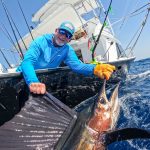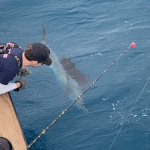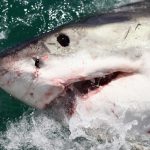Article Courtesy: saltwatersportsman.com | Originally Published: 11/29/17 | Click here for original article
Sailfish Season Never Ends on the East Coast
You can just about fish for sailfish year-round. And that’s even without leaving the East Coast. Kick off the yearlong pursuit in the Carolinas in the summer. As fall comes on, move down the Eastern Seaboard and, in November, hit the central Florida coast, where sailfish season runs through the end of February. Then head south, toward Key West, where they remain abundant through May.
Off North Carolina, Capt. Dan Rooks, who runs Tuna Duck out of Hatteras Village on the Outer Banks makes the 25-mile run to the edge of the continental shelf to begin his hunt. “I look for structure,” he says.
“Whether it’s current, a rip, a color change or bottom structure, you can catch them about anywhere, in 90 feet or 900,.” Pay attention any inshore color change where the water goes from green to blue, or the inshore side of the Gulf Stream. But above all, look for signs of bait. “I pay close attention to the sargassum,” he adds. “When I see minnows, about the size of your little finger, I always do well.”
Rooks trolls a combination of teasers and dead bait. “I pull a couple of squid daisy-chain teasers and naked ballyhoo, dinks rigged on 60- to 80-pound leader.” He sets flat lines to run behind the teasersand rigs both short and long outrigger lines with the same small ballyhoo. All baits are fished on Shimano TLD 25s loaded with braid backing under about 300 yards of 30-pound hi-vis mono.
“A lot of times I’m not targeting sailfish,” he says. “I’m looking for wahoo, and the sails are with them. It’s good wahoo fishing at that time of year, and you can get blackfin tuna and dolphin as well. And I always keep a dink on a flat line and one on the shotgun, fished way back.”
Sailfish off the Outer Banks average about 60 inches, or 45 pounds, says Rooks. “They are large for the weight they carry; they can be long and not heavy.” But what they lack in weight, they make up for in action. “These are acrobatic fish, so it’s a visual and exciting fight on light stand-up tackle.”
“We get going with a surge of fish in early November,” says Capt. Patrick Price of Daymaker Charters in Jensen Beach, Florida, where December and January bring the peak action before it tapers off by late February.
Jensen Beach sits at a teetering point between the primarily dead-bait trolling fishery to the north, where the continental shelf is broad, and the live-bait fishery to the south, where the reef line swings in close to shore and concentrates the fish.
“Early in the season we go north to meet the migrating fish,” he says. “We look for temperature breaks, water-clarity edges from green to blue, and also birds and bait. Any kind of life is a good sign.” It’s not uncommon to find dolphin and sailfish mixed together, Price points out.
“To the north, we use dead baits,” he says. “Up here, we have a wider swath of bottom. Depths from 115 to 130 feet of water could be 5 miles, so we troll at 4½ to 7 knots, with dead chin-weighted ballyhoo on 6/0 and 7/0 hooks on 30- to 50-pound leader.” His typical spread is two flat lines, two short rigger lines, and two long rigger lines, all with small, naked ballyhoo. “We run them with dredge teasers consisting of a mix of rubber fish and real baitfish. We also pull squid daisy chains on the surface.”
To the south the continental shelf swings shoreward, and the farther south you travel toward Jupiter, the narrower the migration lane the sails funnel into. “I can put kite baits in 100 and 200 feet of water at the same time,” Price says. “Due to the sharp drop, sailfish migrate in a smaller zone, and that’s what makes live-baiting more effective.”
The big push of fish begins in November, when the sails first appear in the deeper water beyond the reef. “In the fall, ballyhoo begin showing up in the deeper water, out to 200 feet, and we see a lot of smaller fish then,” explains Capt. Brice Barr, who operates Double Down out of City Marina in Key West. “We’ve gotten into dredge-fishing at that time of year.” he says. “We’ll raise a pack of sailfish, then start throwing live baits at them. That’s how we put up the numbers and get some double-digit days.”
In December the ballyhoo move to shallower water, and the sails follow. “My favorite thing to do is throw live baits when the sailfish are chasing ballyhoo. With sails feeding in just 12 to 20 feet of water, light tackle is in order.”
He fishes 12- to 20-pound spinning tackle, mono line and 20-pound leader. It’s all sight-fishing, and the sails, which hunt in packs and run larger this time of year, strafe the ballyhoo schools, grab a meal, and then drop back to deeper water for a while.
As winter transitions into spring, the sailfish are on the move, working west toward Mexico. “In late March, April and May, we have fish that tail,” says Barr. An eastbound current with the wind running against it create swells on the deep side of the reef in 120 to 150 feet of water. “The sailfish get up on the waves and surf down the swells, and that’s when we throw a bait in front of them.”
What: Atlantic Sailfish
Where: Hatteras, North Carolina, central Florida, and the Florida Keys
When: Year-round; seasonal peaks in different latitudes
Who: Anglers with boats set up for trolling blue water. These experienced pros can put you in the action:
Hatteras, North Carolina: Capt. Dan Rooks, Tuna Duck, 252-216-6160, tunaduck.com Stuart, Florida: Capt. Patrick Price, Daymaker, 772-405-0091, daymakerfishing.com Key West, Florida: Capt. Brice Barr, Double Down, 305-304-2314, fishdoubledown@aol.com









